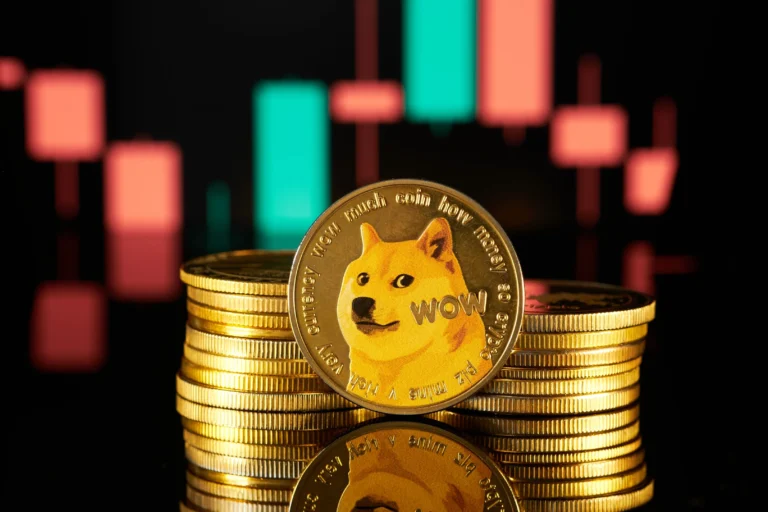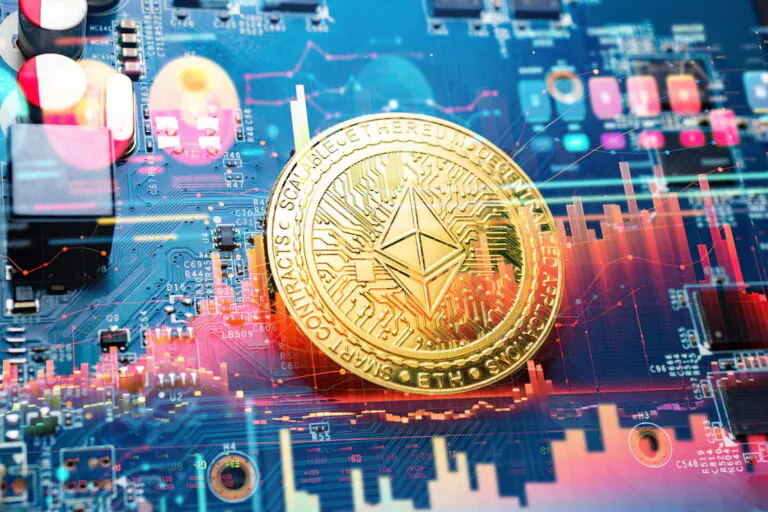Dogecoin (DOGE) with the image of a Shiba Inu dog called Kabosu as its logo, is one of the most popular and successful memecoins. It is considered an altcoin and was launched in December 2013.

IOTA (MIOTA): The Scalable and Secure Cryptocurrency of the Future
We continue to dive into the world of cryptocurrencies and blockchain technologies, and in this article we would like to tell you more about one of the most innovative projects – IOTA. Based on Directed Acyclic Graph (DAG) technology, the IOTA cryptocurrency has many unique features that allow it to be applied in a wide variety of areas. In this article, we will look at what IOTA cryptocurrency is, the history of its creation, how IOTA works, the features of the technology, its advantages and disadvantages, as well as the potential opportunities that it can provide for business and the development of new technologies.
What is IOTA and the history of the creation of the coin
IOTA is a next-generation cryptocurrency designed to enable secure and fast data transfer between devices on the Internet of Things (IoT). It was launched in 2016 and is one of the most promising projects in the field of cryptocurrency and blockchain technologies. The history of the creation of the coin began in 2015, when the founder of the project, David Sonstebo, discovered the limitations of blockchain technology in the field of IoT. He came to the conclusion that traditional cryptocurrencies such as Bitcoin cannot solve the problems of data transmission in the IoT, as they require large computing power to complete transactions and cannot provide the necessary scalability. To solve these problems, Sonstebo developed a new protocol called Tangle. Tangle is a decentralized network that does not require mining and allows you to perform transactions without commissions. It works on the basis of nodes that confirm each other's transactions, which ensures the security and reliability of the system. In June 2016, IOTA was launched as a testnet, and in November of the same year, the official launch took place. Since then, the project has attracted the attention of large corporations such as Microsoft, Samsung and Volkswagen, who are interested in the possibilities of using IOTA technology in the IoT field.
Who created IOTA?
IOTA was created through the joint work of Sergey Ivancheglo, Sergey Popov, David Sonstebo and Dominik Shiner, they became the main participants in the creation, and contributed to the development and promotion of cryptocurrency, which was one of the first designed specifically for IoT devices.
In 2015, it became known about the launch of the project after the notification of the sale of tokens on the Bitcoin forum. The beginning of IOTA comes from the Jinn project, which started its work in 2014. The goal of the project was to create a three-part tool or low-cost and energy-efficient hardware, primarily general purpose processors, to be applied in an IoT system. Jinn made a massive sale of its own tokens, selling approximately 100,000 tokens and generating a profit of approximately $250,000.
After some time, Jinn tokens were in the top, as they were sold as profit-sharing tokens. A little later, Jinn changed its name to IOTA, thus a new trading of symbols took place.
It is important to note that the development of IOTA was linked to the Jinn project and this was one of the key factors leading to its creation. Due to its uniqueness and ease of use, it has become one of the most popular cryptocurrencies in the IoT field and continues to attract the attention of developers and investors around the world.
What is special about IOTA?
IOTA is a cryptocurrency that is based on blockchain technology, but has a number of features that make it unique:
- Free transactions. Unlike others, IOTA cryptocurrency does not have transaction fees. This means that users can transfer money without restrictions and additional costs, which makes it attractive to use as a means of payment.
- There are no limits on the number of transactions. Most cryptocurrencies limit the number of transactions that can be carried out in a certain period of time. There are no such restrictions here, which allows you to ensure the smooth operation of the system.
- Scalability. IOTA is designed to scale easily as the number of users grows. This is achieved thanks to the Tangle technology, which provides parallel processing of multiple transactions.
- Resilience to quantum computing. IOTA uses a cryptographic algorithm called the Winternitz One-Time Signature Scheme (WOTS). This algorithm provides resistance to quantum computing-related attacks which could threaten other cryptocurrencies.
- Ability to use in the Internet of things. IOTA was created specifically for use in the IoT ecosystem. Due to its unique features such as no transaction fees and scalability, it can be effectively used as a means of payment for IoT devices.
The value of these features lies in the fact that they make the cryptocurrency more convenient, faster and safer to use, and also allow it to successfully cope with emerging challenges in the IoT ecosystem. Free transactions and no limits on the number of transactions make it an ideal solution for micropayments and international money transfers. This is especially important for economies where there are many small transactions, such as the IoT sphere, in which IOTA has great potential. Due to the absence of commissions and the possibility of conducting an infinite number of transactions, it can significantly reduce transaction costs and speed up the process of exchanging information and funds between devices. It is also worth noting that IOTA uses the unique Tangle technology, unlike traditional blockchains, which gives it the ability to process transactions more efficiently and without delay, and also improves security and protection against attacks. In addition, thanks to its open source code, it can be used as a basis for creating new and innovative projects, which makes it one of the most promising and interesting blockchain projects today.
IOTA Mining Approach
Mining IOTA is not necessary for confirming transactions, because a different system for confirming transactions is used, which is called Proof-of-Work. Instead of IOTA mining, members must confirm other transactions in order to earn. In the ecosystem, rewards are issued for confirming transactions, the amount depends on the number of confirmations and the complexity of transactions. The more transactions you confirm, the more likely you are to receive a reward. It is also possible to mine using graphics processing units (GPU) and processors (CPU), but this requires significant computing resources and energy. In addition, when working with mining, it must be taken into account that it can have a negative impact on the environment.
However, there is an alternative method called staking. In staking, users must hold a certain amount in an IOTA wallet and confirm other transactions on the network. Rewards are issued for maintaining staking and are based on the amount of IOTA involved in staking. This method is more efficient and environmentally friendly than mining.
Thus, mining is not the main way to earn this cryptocurrency. It can be used as an additional income, but this requires a significant amount of computing resources and energy. Instead, staking is a more efficient and affordable way of mining, which also contributes to ensuring the security of the network and maintaining its operability. In addition, staking has a more environmentally friendly model that does not require large computing power and does not have a negative impact on the environment.
For staking, you need to have a certain amount of MIOTA on your wallet and connect to a network node that provides transaction confirmation. Staking can also have different levels depending on the number of MIOTA that you want to use, as well as the duration of participation in the network. As with other cryptocurrencies, it is important to ensure the security of your assets when working. To do this, you should use reliable wallets and protect your data from unauthorized access. Before you start working with IOTA mining or staking, you need to familiarize yourself with the rules and requirements of the network in order to avoid losing funds or violating the rules.
IOTA Technology
IOTA is a decentralized platform based on distributed ledger technology (DLT) and designed for the machine economy. Uses its own protocol between IoT (Internet of Things) microchips to transfer data and process microtransactions without intermediaries.
IOTA technology has several distinctive features. One of the main features is the use of the concept of "blockchain without blocks" or Directed Acyclic Graph (DAG), which is called Tangle. Tangle is a graph in which each node is a transaction, and in order to confirm a new transaction, some work must be done related to verifying previous transactions. This concept avoids the scalability and performance issues that arise in the blockchain.
Another important feature of the technology is the use of cryptographic hashing algorithms to ensure the security of data and transactions. IOTA uses the SHA-3 cryptographic hashing algorithm, which is the NIST standard and guarantees high resistance to attacks on hash functions.
An important aspect of the technology is its openness and accessibility. It is a freely distributed and open technology that allows developers and users to create and use applications based on this technology without any restrictions.
Cryptocurrency IOTA (MIOTA): course, forecast and prospects
Like any other cryptocurrency project, it faces many factors that can affect the IOTA rate. In particular, economic, technological and market factors can influence the price of MIOTA. Some experts give the following IOTA forecast: this platform has the potential to become one of the main players in the field of the Internet of Things. In addition, the developers continue to work on improving the Tangle technology, which is the basis of this cryptocurrency. Currently, IOTA actively cooperates with a number of large companies, such as Volkswagen, Bosch, Fujitsu, etc., to develop IoT solutions and use Tangle technology. A charitable foundation called the "IOTA Ecosystem Fund" was also created, which provides financial support for the development of projects related to IOTA and Tangle technology.
In conclusion: IOTA technology is an innovative and promising development in the field of distributed systems and machine economy. Its unique features, such as the use of Tangle, prove that IOTA is a promising technology that can become one of the main building blocks of the future of the Internet and the economy. It uses a unique distributed ledger technology that does not require mining and is free for all users. By using Tangle as the core of its technology, IOTA is highly scalable and has low transaction latency, making it ideal for IoT microtransactions.
Despite this, it should be remembered that cryptocurrency markets are extremely unstable and forecasting their future is not an easy task. Therefore, you should make decisions about buying or selling IOTA based on your own research and risk preferences.
Start your crypto exchange with Coin24

Exchange BTC, ETH, USDT and more — cash or card

Secure and fast crypto exchange since 2018



